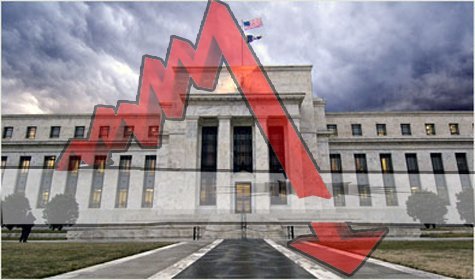Late last year, with the U.S. economy experiencing falling unemployment and seemingly low inflation, observers were extremely confident that the Federal Reserve would move judiciously in 2015 to restore ‘normal’ interest rates sooner rather than later. However, in light of the recent fall in both stocks and oil, that conviction has softened considerably.
Many, such as the very influential Bill Gross, now believe that our current Zero Interest Rate Policy (ZIRP), which has been in place for six years, will remain in place throughout the year. While this likelihood is a disappointment to many, who would have preferred to see the economy move along without Fed-supplied training wheels, few really understand the pernicious effects these policies are inflicting on the economy the longer they are held in place. In short, ZIRP is slowly transforming the world economy into a dysfunctional basket case.
Historically, it has been estimated that a ‘normal’ fair rate of return on short to medium-term high quality debt is between 2 and 2.5 percent, net of inflation. Recently, the Fed published year-on-year U.S. CPI inflation for mid November 2014 at 1.3 percent. This would suggest normal short-term rates at around 3.5 percent at present.
However, using the government’s methodology that was in place prior to 1990, John Williams’ Shadow Government Statistics (SGS) newsletter calculates inflation to be currently some 5 percent. Using methods in place prior to 1980, it is a staggering 9 percent. At that level, current interest rates should be somewhere around 11.0%. Even if we estimate that real inflation is currently 3%, then our “normal” rate of interest should be around 5%. This is some 50 times the rate paid currently on most bank deposits. This gap is distorting the economy in untold ways.
In early December 2014, the U.S. Congress approved further Government spending of some $1.1 trillion. This came just as the U.S. Treasury’s debt broke through a total of $18 trillion. It wasn’t that many months ago that the $17 trillion barrier was first breached.
Currently, the U.S. Treasury can borrow for 10 years at around a rate of 2 percent. But if long term rates rose to 5 percent, which would be in line with the historic range of “normal,” the 3 percent difference would cost the Treasury an additional $540 billion in annual interest payments (based on the current $18 trillion in debt). This would considerably undermine the government’s fiscal position, and necessitate an upheaval in federal budgeting.
The financial repercussions of a tripling or quadrupling of interest rates truly are horrific. They lead to a sense of foreboding that the Fed, aware acutely that the U.S. Treasury simply cannot afford a return to normal interest rates, will not restore normal rates unless forced to do so by international bond or currency markets. It appears, therefore, likely that ZIRP will continue for years to come. This feeling is underpinned by a view that low interest rates are simply a benign stimulant that fails to appreciate the actual harm they impose, particularly in the fixed income markets.
Savings are the prime source of real long-term investment. Today, savers are being crushed by the Fed’s manipulation of interest rates to below a real return. To find even small real returns, investors have had to scour the financial landscape for sources of yield. In doing so, they have ventured into risky territory and have, for instance, flooded into the high yield market, pushing junk yields to record low territory. The repercussions of providing excess capital to risky businesses have yet to be experienced, but the energy industry should provide us with a hint of things to come. Over the last few years small and midsized energy firms were able to borrow cheaply and lavishly to fund drilling projects, thereby greatly increasing production. But in retrospect, these efforts look like they helped create an oversupply of energy that has depressed the price of crude and has exposed the energy sector to long-term financial stress. Bankruptcies and creditor losses may be inevitable.
[slider id=’3303′ name=’ACNO Advertisements’ size=’full’]
Another concern of the Fed is that despite an unprecedented increase in liquidity and part-time employment, real job creation is still sluggish at best. Furthermore, the Manhattan Institute’s Power & Growth Initiative Report of February 2014 notes that the U.S. oil and gas boom has created some one million jobs with a further ten million in associated occupations. The oil boom has improved net employment and kept the economy out of recession. But oil prices have fallen dramatically, threatening these economic bonuses and high-yield bond defaults. It’s hard to see what other distortions and hidden pitfalls have been created by negative real rates. The traps often become visible only after they have been sprung.
But with major economies such as the European Union, Japan and Russia flirting with recession (and China slowing down considerably), there is growing fear that normal interest rates would be dangerous at present. This fear likely will encourage the maintenance of ZIRP, possibly for years, with financial markets disconnected increasingly from the real economy.
Therefore, investors may continue to benefit for some time from the consistent boosting of financial markets by central banks. However, the longer a major correction or even a crash takes to develop, the more sudden, deep and devastating it may be.
John Browne is a consultant with Euro Pacific Capital Inc., a broker-dealer based in Westport, Connecticut. He writes weekly columns for several investment publications across the U.S.


:quality(75)/https://static.texastribune.org/media/files/c47cb8a836a3a61171d7ad02831649e4/Elon%20Musk%20VivaTech%202023%20TT.jpg?w=440&resize=440,264&ssl=1)
:quality(75)/https://static.texastribune.org/media/files/d431da7e82432598bb2a913a2d7b656c/0708%20Lubbock%20Public%20Pools%20AR%2009%20TT.jpg?w=440&resize=440,264&ssl=1)
![Chocolate Prices Set to Surge Amid Cocoa Supply Crisis [VIDEO]](https://i2.wp.com/austincountynewsonline.com/wp-content/uploads/2024/06/chocolate.jpg?w=440&resize=440,264&ssl=1)
:quality(75)/https://static.texastribune.org/media/files/480e214434ccc7208c13495fb0c23f46/RGV%20Citrus%20Freeze%20JG%20TT%2018.jpg?w=440&resize=440,264&ssl=1)